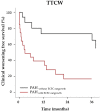Blood Outgrowth and Proliferation of Endothelial Colony Forming Cells are Related to Markers of Disease Severity in Patients with Pulmonary Arterial Hypertension
- PMID: 30486375
- PMCID: PMC6321271
- DOI: 10.3390/ijms19123763
Blood Outgrowth and Proliferation of Endothelial Colony Forming Cells are Related to Markers of Disease Severity in Patients with Pulmonary Arterial Hypertension
Abstract
In pulmonary arterial hypertension (PAH), lung-angioproliferation leads to increased pulmonary vascular resistance, while simultaneous myocardial microvessel loss contributes to right ventricular (RV) failure. Endothelial colony forming cells (ECFC) are highly proliferative, angiogenic cells that may contribute to either pulmonary vascular obstruction or to RV microvascular adaptation. We hypothesize ECFC phenotypes (outgrowth, proliferation, tube formation) are related to markers of disease severity in a prospective cohort-study of 33 PAH and 30 healthy subjects. ECFC were transplanted in pulmonary trunk banded rats with RV failure. The presence of ECFC outgrowth in PAH patients was associated with low RV ejection fraction, low central venous saturation and a shorter time to clinical worsening (5.4 months (0.6⁻29.2) vs. 36.5 months (7.4⁻63.4), p = 0.032). Functionally, PAH ECFC had higher proliferative rates compared to control in vitro, although inter-patient variability was high. ECFC proliferation was inversely related to RV end diastolic volume (R² = 0.39, p = 0.018), but not pulmonary vascular resistance. Tube formation-ability was similar among donors. Normal and highly proliferative PAH ECFC were transplanted in pulmonary trunk banded rats. While no effect on hemodynamic measurements was observed, RV vascular density was restored. In conclusion, we found that ECFC outgrowth associates with high clinical severity in PAH, suggesting recruitment. Transplantation of highly proliferative ECFC restored myocardial vascular density in pulmonary trunk banded rats, while RV functional improvements were not observed.
Keywords: endothelial colony forming cell; endothelial progenitor cell; pulmonary hypertension; pulmonary vascular disease.
Conflict of interest statement
The authors declare no conflict of interest.
Figures




Similar articles
-
Combined hypoxia inducible factor-1α and homogeneous endothelial progenitor cell therapy attenuates shunt flow-induced pulmonary arterial hypertension in rabbits.J Thorac Cardiovasc Surg. 2015 Sep;150(3):621-32. doi: 10.1016/j.jtcvs.2015.05.035. Epub 2015 May 15. J Thorac Cardiovasc Surg. 2015. PMID: 26071969
-
Utility of right ventricular Tei-index for assessing disease severity and determining response to treatment in patients with pulmonary arterial hypertension.J Cardiol. 2014 Feb;63(2):149-53. doi: 10.1016/j.jjcc.2013.07.002. Epub 2013 Sep 4. J Cardiol. 2014. PMID: 24012334
-
Treprostinil indirectly regulates endothelial colony forming cell angiogenic properties by increasing VEGF-A produced by mesenchymal stem cells.Thromb Haemost. 2015 Oct;114(4):735-47. doi: 10.1160/TH14-11-0907. Epub 2015 Jun 11. Thromb Haemost. 2015. PMID: 26062754 Free PMC article.
-
RV pressure overload: from hypertrophy to failure.Cardiovasc Res. 2017 Oct 1;113(12):1423-1432. doi: 10.1093/cvr/cvx145. Cardiovasc Res. 2017. PMID: 28957530 Review.
-
Right heart adaptation to pulmonary arterial hypertension: physiology and pathobiology.J Am Coll Cardiol. 2013 Dec 24;62(25 Suppl):D22-33. doi: 10.1016/j.jacc.2013.10.027. J Am Coll Cardiol. 2013. PMID: 24355638 Review.
Cited by
-
Exacerbated inflammatory signaling underlies aberrant response to BMP9 in pulmonary arterial hypertension lung endothelial cells.Angiogenesis. 2020 Nov;23(4):699-714. doi: 10.1007/s10456-020-09741-x. Epub 2020 Aug 19. Angiogenesis. 2020. PMID: 32813135 Free PMC article.
-
Stem cell therapy for pulmonary arterial hypertension: An update.J Heart Lung Transplant. 2022 Jun;41(6):692-703. doi: 10.1016/j.healun.2022.02.020. Epub 2022 Mar 6. J Heart Lung Transplant. 2022. PMID: 35341679 Free PMC article. Review.
-
Development of a 3-Dimensional Model to Study Right Heart Dysfunction in Pulmonary Arterial Hypertension: First Observations.Cells. 2021 Dec 20;10(12):3595. doi: 10.3390/cells10123595. Cells. 2021. PMID: 34944102 Free PMC article.
-
Pathological Roles for Endothelial Colony-Forming Cells in Neonatal and Adult Lung Disease.Am J Respir Cell Mol Biol. 2023 Jan;68(1):13-22. doi: 10.1165/rcmb.2022-0318PS. Am J Respir Cell Mol Biol. 2023. PMID: 36215049 Free PMC article. Review.
-
Endothelial Senescence: A New Age in Pulmonary Hypertension.Circ Res. 2022 Mar 18;130(6):928-941. doi: 10.1161/CIRCRESAHA.121.319815. Epub 2022 Mar 17. Circ Res. 2022. PMID: 35298304 Free PMC article. Review.
References
-
- Vonk-Noordegraaf A., Haddad F.O., Chin K.M., Forfia P.R., Kawut S.M., Lumens J., Naeije R., Newman J., Oudiz R.J., Provencher S., et al. Right Heart Adaptation to Pulmonary Arterial-Hypertension: Physiology and Pathobiology. J. Am. Coll. Cardiol. 2013;62:D22–D33. doi: 10.1016/j.jacc.2013.10.027. - DOI - PubMed
MeSH terms
Substances
Grants and funding
LinkOut - more resources
Full Text Sources
Medical

